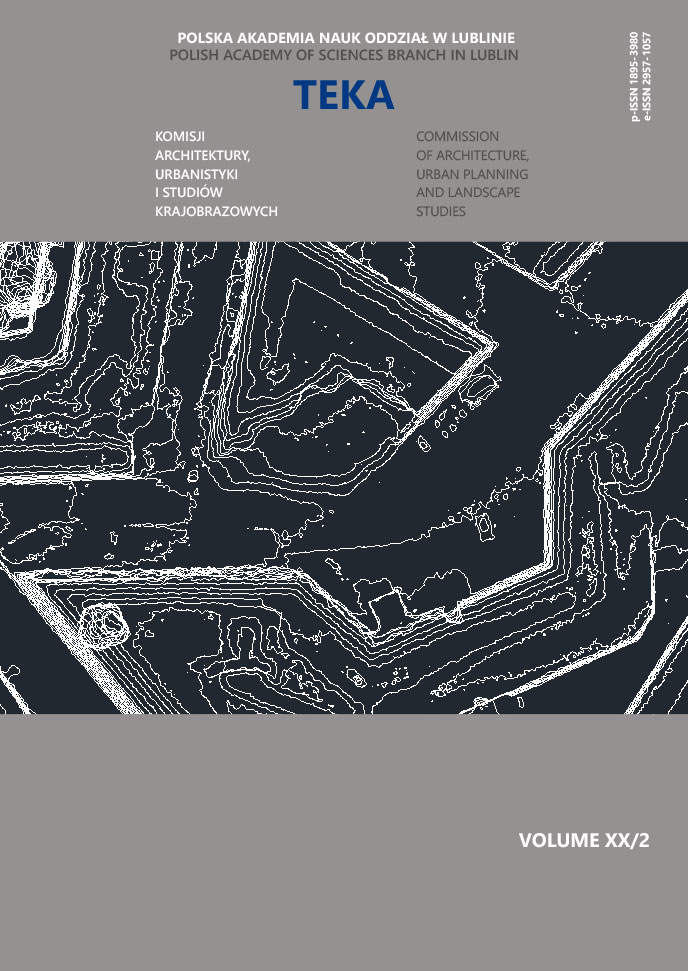Optimal parking solutions in a limited space: analysis for the area around the Rest House for Employees of Lublin University of Technology in Kazimierz Dolny
Article Sidebar
Open full text
Issue Vol. 20 No. 2 (2024)
-
Research issues of church architecture on the eastern borderlands of Poland
Kostiantyn Pinkovskyi, Jan Wrana7-13
-
Children's painting as a tool for communicating needs and values in terms of spatial planning
Aleksandra Sztorc, Jagoda Wawszczak, Paweł Wiśniewski14-22
-
Innovative Architectural Learning: A Case Study on Multidisciplinary and Experiential Teaching Methods
Luis Moreira Pinto, Muhammet Emin Guner23-41
-
Pavilion of the Lusatian Culture Archaeological Reserve in Częstochowa-Raków – a Case Study
Emilia Malec-Zięba42-50
-
Seasonality in the Design of the Environment of a Hotel Facility on the Example of the Rest House for Employees of Lublin University of Technology in Kazimierz Dolny
Damian Hołownia, Dominika Lisiewska51-61
-
Optimal parking solutions in a limited space: analysis for the area around the Rest House for Employees of Lublin University of Technology in Kazimierz Dolny
Aleksandra Sztorc, Aleksandra Typek62-72
-
Dialogue between history and modernity in the preservation of historical ruins: The case of Helfštýn Castle
Katarzyna Drobek, Tetyana Kashchenko73-88
Archives
-
Vol. 20 No. 3
2024-12-27 7
-
Vol. 20 No. 2
2024-12-27 7
-
Vol. 20 No. 1
2024-12-27 8
-
Vol. 19 No. 2
2023-12-29 11
-
Vol. 19 No. 1
2023-12-19 13
-
Vol. 18 No. 4
2022-12-30 5
-
Vol. 18 No. 3
2022-12-27 5
-
Vol. 18 No. 2
2022-12-27 5
-
Vol. 18 No. 1
2022-12-27 4
-
Vol. 17 No. 4
2021-12-30 11
-
Vol. 17 No. 3
2021-12-30 9
-
Vol. 17 No. 2
2021-12-30 8
-
Vol. 17 No. 1
2021-12-30 8
-
Vol. 16 No. 4
2020-12-30 11
-
Vol. 16 No. 3
2020-09-30 10
-
Vol. 16 No. 2
2020-06-30 11
-
Vol. 16 No. 1
2020-03-31 10
Main Article Content
DOI
Authors
Abstract
The study was aimed at selecting optimal parking solutions for the Rest House for Employees of Lublin University of Technology in Kazimierz Dolny, taking into account functional, ecological and aesthetic aspects. The location and surroundings of the facility required the design of a car park that would meet technical requirements and blend harmoniously with the surroundings. The site required improved aesthetics and functionality. This included creating more biologically active areas and separating the car park from the playground. The proposed changes included the use of appropriate surfacing materials to allow the car park space to blend into the natural landscape. The design concept included the addition of greenery to increase safety and comfort, as well as a shed with photovoltaic panels that could generate electricity. This design would optimise the functionality of the car park, influence the sustainability of the space and improve the aesthetics of the site.
Keywords:
References
Burdziński, J. (2007). Parking—Elementem krajobrazu miasta. Architektura Krajobrazu, nr 3, 49−54.
Burdziński, J. (2012). Odnowa wizerunku terenów parkingowych. Architektura Krajobrazu, nr 3.
Bykowski, J., & Krawczyńska, E. (2011a). Techniczne aspekty projektowania parkingów przy obiektach użyteczności publicznej. Drogownictwo, nr 1, 8−14.
Bykowski, J., & Krawczyńska, E. (2011b). Techniczne aspekty projektowania parkingów przy obiektach użyteczności publicznej. Drogownictwo, nr 1, 8−14.
Chojecka, A. (2014). Znaczenie terenów zielonych w przestrzeni publicznej oraz ich wpływ na jakość życia miejskiego. Rynek – Społeczeństwo – Kultura, 1, 48−54.
Kopciowski, D. (2010). Ochrona zabytkowych wartości Kazimierza Dolnego. Przestrzeń i Forma, nr 13, 99−134.
Małek, A., & Kowalczyk, D. (2016). Carport fotowoltaiczny do ładowania pojazdów elektrycznych. Autobusy : technika, eksploatacja, systemy transportowe, 17(11), 93−97.
Maršanic, R., Mrnjavac, E., Pupavac, D., & Krpan, L. (2021). Stationary Traffic as a Factor of Tourist Destination Quality and Sustainability. Sustainability, 13(7), Article 7. https://doi.org/10.3390/su13073965 DOI: https://doi.org/10.3390/su13073965
Sarna, A. (2010). Zasady projektowania wielkopowierzchniowych parkingów naziemnych przyjaznych dla krajobrazu i środowiska. Transport Miejski i Regionalny, nr 3.
Siedlecka, M., & Suchocka, M. (2017). Wodoprzepuszczalne nawierzchnie a zrównoważony rozwój terenów miejskich. Drogownictwo, nr 2.
Strzałkowski, P. (2018). Wymagania i metody badań dla wybranych wyrobów z kamienia naturalnego. Górnictwo Odkrywkowe, R. 59, nr 5.
Szmygin, B. (2004). WSPÓŁCZESNE PROBLEMY OCHRONY MIASTA HISTORYCZNEGO KAZIMIERZ DOLNY NAD WISŁĄ. Ochrona Zabytków, 3−4, 7−28.
Uchwała Nr XLIV/311/22 Rady Miejskiej w Kazimierzu Dolnym z dnia 28 września 2022 roku w sprawie miejscowego planu zagospodarowania przestrzennego dla części obszaru gminy Kazimierz Dolny, w obrębach: Kazimierz Dolny, Mięćmierz-Okale, Cholewianka. (2022, September 28).
Article Details
Abstract views: 125



